
The Epipalaeolithic Near East designates the Epipalaeolithic in the prehistory of the Near East. It is the period after the Upper Palaeolithic and before the Neolithic, between approximately 20,000 and 10,000 years Before Present (BP). The people of the Epipalaeolithic were nomadic hunter-gatherers who generally lived in small, seasonal camps rather than permanent villages. They made sophisticated stone tools using microliths—small, finely-produced blades that were hafted in wooden implements. These are the primary artifacts by which archaeologists recognise and classify Epipalaeolithic sites.
The Levant is the large area in Southwest Asia, south of the Taurus Mountains, bounded by the Mediterranean Sea in the west, the Arabian Desert in the south, and Mesopotamia in the east. It stretches 400 mi (640 km) north to south from the Taurus Mountains to the Sinai desert, and 70–100 mi (110–160 km) east to west between the sea and the Arabian desert. The term is also sometimes used to refer to modern events or states in the region immediately bordering the eastern Mediterranean Sea: Cyprus, Israel, Jordan, Lebanon, Palestine, Syria and the Hatay Province of Turkey.

The Mesolithic is the Old World archaeological period between the Upper Paleolithic and the Neolithic. The term Epipaleolithic is often used synonymously, especially for outside northern Europe, and for the corresponding period in the Levant and Caucasus. The Mesolithic has different time spans in different parts of Eurasia. It refers to the final period of hunter-gatherer cultures in Europe and Western Asia, between the end of the Last Glacial Maximum and the Neolithic Revolution. In Europe it spans roughly 15,000 to 5,000 BP; in Southwest Asia roughly 20,000 to 8,000 BP. The term is less used of areas further east, and not at all beyond Eurasia and North Africa.
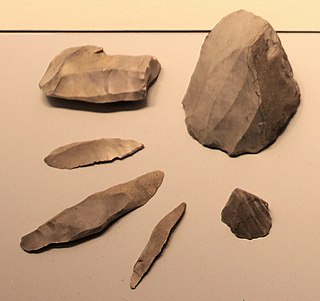
A microlith is a small stone tool usually made of flint or chert and typically a centimetre or so in length and half a centimetre wide. They were made by humans from around 35,000 to 3,000 years ago, across Europe, Africa, Asia and Australia. The microliths were used in spear points and arrowheads.
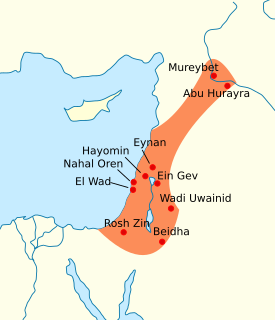
The Natufian culture is a Late Epipaleolithic archaeological culture of the Levant, dating to around 15,000 to 11,500 years ago. The culture was unusual in that it supported a sedentary or semi-sedentary population even before the introduction of agriculture. The Natufian communities may be the ancestors of the builders of the first Neolithic settlements of the region, which may have been the earliest in the world. Some evidence suggests deliberate cultivation of cereals, specifically rye, by the Natufian culture, at Tell Abu Hureyra, the site of earliest evidence of agriculture in the world. The world's oldest evidence of bread-making has been found at Shubayqa 1, a 14,500-year-old site in Jordan's northeastern desert. In addition, the oldest known evidence of beer, dating to approximately 13,000 BP, was found at the Raqefet Cave in Mount Carmel near Haifa in Israel.

The Kebaran culture, also known as the Early Near East Epipalaeolithic, was an archaeological culture in the eastern Mediterranean area, named after its type site, Kebara Cave south of Haifa. The Kebaran were a highly mobile nomadic population, composed of hunters and gatherers in the Levant and Sinai areas who used microlithic tools.
Harifian is a specialized regional cultural development of the Epipalaeolithic of the Negev Desert. It corresponds to the latest stages of the Natufian culture.

Es-Skhul or the Skhul Cave is a prehistoric cave site situated about 20 km (12.4 mi) south of the city of Haifa, Israel, and about 3 km (1.9 mi) from the Mediterranean Sea.
The Baradostian culture was an Upper Paleolithic flint industry culture found in the Zagros region in the border-country between Iraq and Iran. It was preceded by the Middle Paleolithic Mousterian culture, directly overlying it without an intervening bladelet industry. This culture is known for the high percentage of burins and some of these were similar to the distinctive nosed profile of the Aurignacian burins. Baradost is one of the mountains in the Zagros Mountains in Iraq.
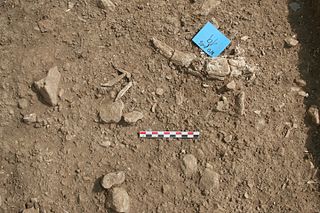
Neve David is an Epipalaeolithic archaeological site located at the foot of the western slope of the Mount Carmel hills in northern Israel. It was inhabited in the later part of the Middle Epipalaeolithic, about 15,000–13,000 BC.

The prehistory of the Iberian Peninsula begins with the arrival of the first hominins 1.2 million years ago and ends with the Punic Wars, when the territory enters the domains of written history. In this long period, some of its most significant landmarks were to host the last stand of the Neanderthal people, to develop some of the most impressive Paleolithic art, alongside southern France, to be the seat of the earliest civilizations of Western Europe and finally to become a most desired colonial objective due to its strategic position and its many mineral riches.

Warwasi is a Paleolithic rockshelter site located at north of Kermanshah in western Iran. It was excavated by Bruce Howe under direction of late Robert Braidwood in the 1960s. This site contains a rich archaeological sequence from Middle Paleolithic to late Epipaleolithic.

The Iberomaurusian is a backed bladelet lithic industry found near the coasts of Morocco, Algeria, and Tunisia. It is also known from a single major site in Libya, the Haua Fteah, where the industry is locally known as the Eastern Oranian. The Iberomaurusian seems to have appeared around the time of the Last Glacial Maximum (LGM), somewhere between c. 25,000 and 23,000 cal BP. It would have lasted until the early Holocene c. 11,000 cal BP.

The Mushabian culture is an archaeological culture suggested to have originated among the Iberomaurusians in North Africa, though once thought to have originated in the Levant.
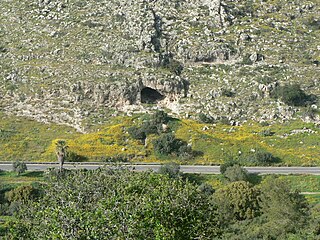
Nahal Oren is an archaeological site on the northern bank of the wadi of Nahal Oren (Hebrew)/Wadi Fallah (Arabic) on Mount Carmel, 10 km (6.2 mi) south of Haifa, Israel. The site comprises a cave and the small terrace in front of it, which steeply descends towards the wadi floor. The site was first excavated in 1941. Kebaran, Natufian (Epipaleolithic) and Pre-Pottery Neolithic A and B industries were found.

The Nachcharini cave is located at a height of 2,100 m (6,889.76 ft) on the Nachcharini Plateau in the Anti-Lebanon mountains near the Lebanese/Syrian border and among the most elevated Natufian and Khiamian hunter-gatherer occupation sites found to date.

The prehistory of the Iranian plateau, and the wider region now known as Greater Iran, as part of the prehistory of the Near East is conventionally divided into the Paleolithic, Epipaleolithic, Neolithic, Chalcolithic, Bronze Age and Iron Age periods, spanning the time from the first settlement by archaic humans about a million years ago until the beginning historical record during Neo-Assyrian Empire, in the 8th century BC.
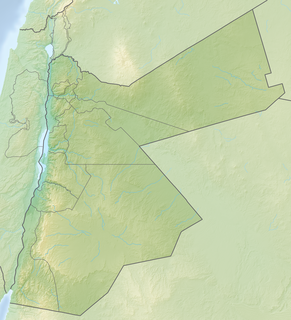
Iraq ed-Dubb, or the Cave of the Bear, is an early Neolithic archeological site 7 km (4.3 mi) northwest of Ajlun in the Jordan Valley, in modern-day Jordan. The settlement existed before 8,000 BCE and experimented with the cultivation of founder crops, side by side with the harvesting of wild cereals. Along with Tell Aswad in Syria, the site shows the earliest reference to domestic hulled barley between 10,000 and 8,800 BCE. The site is located on a forested limestone escarpment above the Wadi el-Yabis in northwest Jordan. An oval-shaped stone structure was excavated along with two burials and a variety of animal and plant remains.
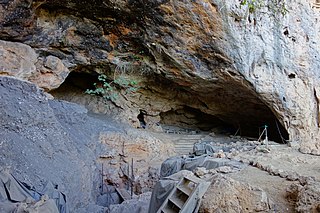
Taforalt or Grotte des Pigeons is a cave in the province of Berkane, Béni Iznasen region, Morocco, possibly the oldest cemetery in North Africa. It contained at least 34 Iberomaurusian adolescent and adult human skeletons, as well as younger ones, from the Upper Palaeolithic between 15,100 and 14,000 calendar years ago. There is archaeological evidence for Iberomaurusian occupation at the site between 23,200 and 12,600 calendar years ago, as well as evidence for Aterian occupation as old as 85,000 years.
Trialetian is the name for an Upper Paleolithic-Epipaleolithic stone tool industry from the South Caucasus. It is tentatively dated to the period between 16,000 / 13,000 BP and 8,000 BP.

















